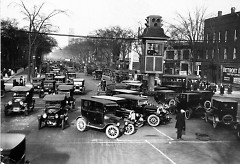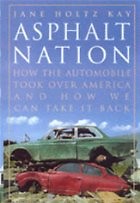This is the last part of a five-part series that explores the effects of the automobile on us as a population and on Grand Rapids. This segment shows what automobile trends GR shares with the nation.
Over the course of the twentieth century, the automobile rapidly developed from an expensive toy for the rich into the de facto standard for passenger transport in the United States. It introduced sweeping changes in employment patterns, social interactions and infrastructure.
The introduction of the mass-produced automobile represented a revolution in mobility and convenience. However, the modern consequences of heavy automotive use has contributed to the addiction to non-renewable fuels, a dramatic increase in the rate of accidental death, social isolation and community disconnect, a sharp rise in obesity and air and noise pollution. It also has been the catalyst for urban sprawl.
In her book, Asphalt Nation: How the Automobile Took Over the Nation and How We Can Take it Back, Jane Holtz Kay enlightens us to some disturbing facts.
According to the Environmental Protection Agency (EPA), the present average weight of a U.S. automobile is 4,066 pounds. According to the American Medical Association (AMA) the average weight of a male is 160 lbs and the average weight of a female is 130 lbs. Does it make sense to use such a large amount of raw materials to transport one small organism?
The EPA says that the average size of a compact car is 100-109 cubic feet. That is a lot of space displacement for one human being to use for transportation. If you go to the mall or to the supermarket and look at the building and at the parking lot you notice that the parking lot is usually triple the size of the building. We have designed huge asphalt prairies around our buildings.
What is the monetary cost of cars? According to the American Automobile Association (AAA) the average American car costs $7,200 a year. The United States federal and state governments spend $200 million dollars a day building, improving, and repairing streets and roads. For every dollar spent on public transportation, seven are spent to support the car. According to this years city budget only two Capital projects pertaining to parking services and traffic safety will cost us $987,000. Imagine if we dedicated half of that towards our crumbling public education system in this city.
Is an automobile an investment? If you buy a $125,000 house on a 30-year mortgage, you will have paid a total of about $250,000 for your house. With appreciation, your house will probably be worth more than $250,000 by the time the mortgage is paid off. If you own two cars while you are paying your 30-year mortgage, and each car costs $20,000 and lasts seven years, you will have spent $440,000 on cars by the time you own your house and have nothing to show for it.
Approximately 47,000 Americans are killed on highways each year. Pedestrians and bicyclists make up 10,000 of these individuals. According to the Michigan Office of Highway Safety Planning In 2008, 56 individuals were killed around the Grand Rapids area. An additional 4,614 were injured. In 2009, 51 people were killed. In the last two years, we have lost 107 individuals to traffic accidents.
In my mind, the automobile addressed a series of problems after World War Two. It gave America jobs and spurred growth. All good things come to an end. I read an article a long time ago that talked about human reaction to danger; our nervous systems are not set up to react to things that take a long time to set in. That is why we are not as concerned about global warming and the destruction of our environment. We need to start embracing public transportation. There will always be some sort of single passenger transportation. We just have to get out of the paradigm in which we use a car to get everywhere and also begin to live closer to work. We have to change for the good of our economy and our environment.
Part I: The clash between the streetcar industry and automobile industry
Part II: The automobile's detrimental toll on community life
Part III: Ways to modify cities to accommodate alternative transportation
Part IV: Current efforts in Grand Rapids for strengthening alternative transportation
Part V: Did the car ever make sense?
The Rapidian, a program of the 501(c)3 nonprofit Community Media Center, relies on the community’s support to help cover the cost of training reporters and publishing content.
We need your help.
If each of our readers and content creators who values this community platform help support its creation and maintenance, The Rapidian can continue to educate and facilitate a conversation around issues for years to come.
Please support The Rapidian and make a contribution today.



Comments
another solid and well thought series! i liked it a lot. it really falls in line with some of what is happening for me these days... trying to live local and greener... i am now a proud Rapid Rider having sold my ancient VW that always needed repairs ($1100.00 in since October 2009!)